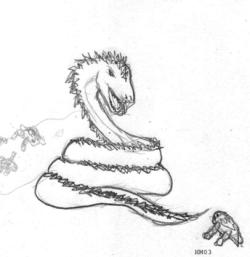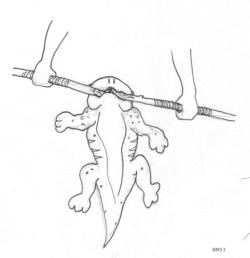
APAGear - Volume 5, Number 6 - October 2003
A creature found in nearly every Southern swamp, the Terranovan Hellfrog is a common and oft-ignored member of the jungle biosphere to which it belongs. Distantly related to the common Hopper species that thrive in more arid climes, the Hellfrog (or Harrimans' Hellfrog, as it is more properly known, at least in the Mekong Dominion) is a relatively common animal often dismissed as a minor prey species and given little further consideration by nature enthusiasts and scientists alike.
Needless to say, were that the actual truth, this would make for a very dull dissertation. In fact, its' very proliferation is a testament to the adaptability and resillience of both the Greater and Lesser species of Terranovan Hellfrog. Furthermore, that they are so ubiquitous makes any description of their capabilities a veritable survival guide to the southern hemisphere.

Given their appearance, one would not estimate the odds of survival for the average Pseudobufo Maleficarnensis Magnus (Greater Hellfrog) as being terribly great. A squat quadrupedal creature approximately thirty kilograms in weight and shaped along the lines of a terran toad, not even the flamboyant trident-shaped patch of fluorescing spines along its' back dispels the humorous expression and typically innocuous behavior of this species. The broad uward curve of the jaw combined with the beady eyes seem to make the creatures' expression jovial in a dimwitted manner that actually coincides with its' intellectual capabilites.
Similarly, it's waddling gait and chuckling calls make it seem even more harmless the the uninformed. Unfortunately, the wide-set and innocuous eyes that many percieve as "endearing" are actually unusually sharp for a Terranovan animal, allowing a Hellfrog to spot small prey at a distance of up to fifty meters, and the humorous waddling gait actually provides an excellent combination of speed and clearance for hunting beneath the meter-high cieling of ferns common to most southern jungles. Despite the presumptive name, the Hellfrog is not naturally amphibious.

Further compromising the aura of harmlessness is the wrinkled curve of the mouth, giving the animal what most people consider to be a content sort of expression. But, of course, the structure of the jaw has nothing to do with asthetics and everything to do with survival. The bulges that give the Hellfrog its' comical cheeks are actually dense bundles of musculature that allow the lower jaw to clamp shut with phenomenal force, burying three double-pointed fangs deep into prey or simply shearing off the entire mouthfull of meat. Much like a terran snapping-turtle or bulldog, this arrangement makes the release of jaw pressure almost impossible, and there have been stories of colonization-era explorers who had taken months-long expeditions into the deep jungle returning with dozens of lesser hellfrogs (or their severed heads) still hanging firmly onto vital pieces of equipment.
Also, the fluorescent trident atop the Hellfrogs' back is composed of hundreds of small quills, each containing a small dose of a sopoforic/paralytic enzyme that can stagger a Barnaby long enough to facilitate a rapid exit. For humans, the spines represent a more serious threat, as the paralytic enzyme can cause severe bronchial constriction (and consequently asphyxiation if untreated) in about ten percent of all individuals.
However, despite the formidable armament, the Greater Hellfrog is most commonly an insectivore, preying on the populous colonies of Army Skags, Crabflies, and Architect Beetles that thrive in its' preferred biosphere. Small prey animals like Basali Sewer Rats (actually a sort of hexapedal insectoid), jungle Hoppers, and imported terran nutria, capybara, and muskrat all fall well within its' dietary paradigms.
The lesser Hellfrog is a different matter. Nearly physiologically identical save for size, the difference in mass seems to have been compensated for by an exponential amplification of its' natural agression. Typically content to live as its' greater cousin, when threateaned or presented an opportunity to finish off a wounded animal the Lesser Hellfrog proves itself to be one of the fiercest species to inhabit the antarctic.
Immediately upon being attacked by a predator (or spotting a viable meal too large to kill by itself), the Hellfrog will literally scream for help, a sympathetic nervous reaction that can even continue for fifty to seventy seconds after death. The ominous harmonic wailing can reach over a hundred and twenty decibels and last for almost two minutes, summoning every Hellfrog within earshot.

Commonly described as something like the sound of someone being murdered with a jackhammer, this screeching croak is the battlecry that usually precedes a tidal wave of between fifty and a hundred small amphibians ready to swarm and devour the predator like a carpet of hopping speudoamphibian pirhanna. Many scientists studying the Southern Porcupine Anaconda believe its' particular spiny adaptation is actually a defense against just such attacks, especially given the snakes' apparent preference for both varieties of pseudo-frog.
Given it's particular habits, the Hellfrog is both a blessing and a curse to humans living in or around the rainforests of the southern pole. On the one hand, the frogs are individually innocuous and amusing, sometimes even kept as pets or incorporated into the large terrarium tanks in the foyers of many Mekong office buildings. Conversely, problems arise when loggers or unlucky tourists startle the occasional Lesser Hellfrog and are consequently swarmed. Similarly, in places where major roadways are proximate to Hellfrog habitat a single roadkill can often lead to more severe problems. There are perhaps a hundred hellfrog-related fatalities annually in the south, with about a quarter of these due to allergic reactions from the shed spines of domesticated pets.
Currently, the advertisement branch of Mekong Consumer Products is attempting to use this humorous reptile as mascot for a line of childrens' products and as the subject of an animated series, in the hopes of stealing market share from the currently reigning "Barnaby." This is meeting some resistance from medical and ecological sources who fear the risks to children should such a character become popular, while the B Compagnie of the Republican Sea Serpents regiments' elite PIM complement is unaware that their nickname (which given as a mocking descriptor of their typical bar-fighting strategy rather than as an intimidating title) may soon be shared with a lovable childrens' franchise.
22 kg average weight 50 m deep visual cone, 210 degrees wide 25 kph running speed for short distances amphibious AGI: -1 BLD: -2 FIT: +1 INS: -1 PER: -1 WIL: +2 STR: -1 HEA: +1 STA: 20 UD: 2
Skills:
Bite (Hand to Hand) 2/1
Special Abilities:
Sopoforic Spines: Potency 5, onset of five rounds. One in ten chance of an allergic reaction requiring medical attention within 1d6 hours.
Clamp: On each sucessful or parried sucessful attack by the hellfrog, it has a one-in-four chance of having it's jaws lock such on whatever it struck. The 'frog will remain attached, doing the same amount of damage for each consecutive turn until it rolls another four, at which point it releases. If the initial attack hit but did no damage to the player, the hellfrog can be shed by discarding an article of equipment. If the attack was parried, this must be the weapon used, since it's hard to swing or even hold onto a sabre or machete with a twenty-kilo frog attached to the tip.

Agressiveness: 4 Damage/turn: x8 Threshold: 3 Random Swarm Size: 4d6 Basic Swarm Size: 20
Shares Sopoforic Spines ability as described above.
Heavy Gear and Jovian Chronicles are © Dream Pod 9, Inc. All rights reserved. APAGear is not affiliated with Dream Pod 9 in any way. Submitted material remains the property of its creator.